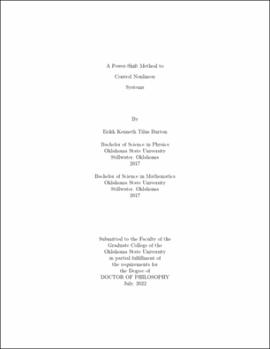| dc.contributor.advisor | Bandy, Donna K. | |
| dc.contributor.author | Burton, Erikk Kenneth Tilus | |
| dc.date.accessioned | 2023-04-05T16:20:45Z | |
| dc.date.available | 2023-04-05T16:20:45Z | |
| dc.date.issued | 2022-07 | |
| dc.identifier.uri | https://hdl.handle.net/11244/337263 | |
| dc.description.abstract | A theoretical technique is developed herein which allows for the experimental access of attractors in a coherent laser with injected signal. This technique is theoretically tested for use in other nonlinear systems such as an optomechanical system. The technique, known as the power-shift method, works by rapidly changing the control parameter of the nonlinear dynamical system in order to access specific dynamics in the system. | |
| dc.description.abstract | Noise and time lags in the shift are added to study the viability of the technique under experimental conditions. The time lags are found in some situations to enhance the effectiveness of the power-shift method. Another version of the power-shift method is developed which generalizes the technique to other system parameters, namely the gain parameter. Pulse versions of the technique are tested using Gaussian, sech2, and square wave pulses. The pulses are initially tested with a constant peak and then with a constant area under the curve while varying the full width half maximum. | |
| dc.description.abstract | The power-shift method is also tested in an optomechanical system. In this system, the power-shift method succeeds and possesses a new option in the form of shifting from stable system points. By using stable points, the system need not be timed to access attractors therefore removing a potential point of failure. | |
| dc.description.abstract | The investigation finds that the power-shift method is able to access coexisting attractors with small levels of noise and with time lags in the power shift. Of the pulse variants, the square wave shows the most promise; this is followed by the Gaussian pulse. The investigation finds that fast intense pulses are effective at perturbing the system to an attractor. | |
| dc.description.abstract | Finally, examples of how a power-shift method might be executed experimentally are demonstrated along with examples shown in the laser with injected signal and the optomechanical system. | |
| dc.format | application/pdf | |
| dc.language | en_US | |
| dc.rights | Copyright is held by the author who has granted the Oklahoma State University Library the non-exclusive right to share this material in its institutional repository. Contact Digital Library Services at lib-dls@okstate.edu or 405-744-9161 for the permission policy on the use, reproduction or distribution of this material. | |
| dc.title | Power-shift method to control nonlinear systems | |
| dc.contributor.committeeMember | Haley, Joeseph | |
| dc.contributor.committeeMember | Rosenberger, Albert T. | |
| dc.contributor.committeeMember | Blum, Frank | |
| osu.filename | Burton_okstate_0664D_17748.pdf | |
| osu.accesstype | Open Access | |
| dc.type.genre | Dissertation | |
| dc.type.material | Text | |
| dc.subject.keywords | attractors | |
| dc.subject.keywords | nonlinear | |
| thesis.degree.discipline | Physics | |
| thesis.degree.grantor | Oklahoma State University | |
